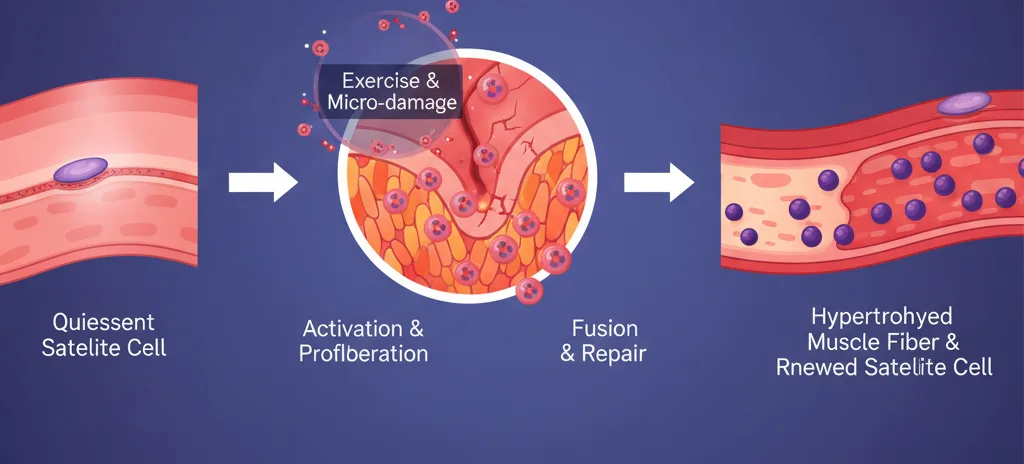Have you ever wondered how your muscles recover and grow stronger after a tough workout? While protein synthesis and muscle fiber repair get a lot of attention, there's a crucial, often overlooked player in this process: satellite cells. These microscopic powerhouses are essential for muscle regeneration, repair, and hypertrophy (growth).
What Are Satellite Cells?
Satellite cells are a unique type of adult stem cell found nestled on the surface of mature muscle fibers, sandwiched between the sarcolemma (the muscle fiber's cell membrane) and the basal lamina (a connective tissue layer). In their resting state, they are largely dormant and inactive in terms of cell division. Think of them as a strategic reserve army, quietly awaiting the call to action.
The Call to Action: How They Get Activated
The primary trigger for satellite cell activation is muscle damage or stress, typically induced by physical activity, especially resistance training or unaccustomed exercise. When you lift weights or perform strenuous activity, microscopic tears occur in your muscle fibers. This damage releases various signaling molecules, growth factors, and inflammatory cytokines (like HGF, IGF-1, and interleukins) into the local environment.
These chemical signals act as an alarm, rousing the quiescent satellite cells from their dormant state. Upon activation, they move from their resting position, begin to express specific proteins, and enter the cell cycle.
Quantity Control: How They Increase
Once activated, satellite cells don't just spring into action individually; they undergo a process of extensive proliferation, meaning they begin to multiply rapidly through cell division (mitosis). This dramatically increases the pool of available cells. This expansion of the satellite cell population is critical because more cells mean greater capacity for repair and growth.
Their Pivotal Role in Muscle Repair and Growth
The newly proliferated satellite cells then have a dual role:
-
Muscle Fiber Repair: When muscle fibers are damaged, these new satellite cells migrate to the injury site. They then fuse with existing damaged muscle fibers, donating their nuclei to help repair and rebuild the fiber. This addition of new nuclei is vital, as it allows the muscle fiber to increase its protein synthesis capacity, which is essential for both repair and growth. Each nucleus essentially controls a certain "domain" of the muscle fiber, and adding more nuclei expands this domain, enabling the fiber to grow larger.
-
Formation of New Muscle Fibers (to a lesser extent): In cases of severe damage or specific conditions, activated satellite cells can also fuse with each other to form entirely new muscle fibers (myogenesis), although this is less common than fusing with existing fibers.
Satellite Cells and Sport Performance
The importance of satellite cells in sports and physical performance cannot be overstated:
-
Strength Training & Hypertrophy: For athletes focused on building muscle mass and strength, satellite cells are fundamental. The repeated cycles of damage and repair from resistance training lead to consistent satellite cell activation and fusion, driving the sustained increase in muscle fiber size. Individuals with a greater capacity to activate and utilize satellite cells often show superior hypertrophic responses to training.
-
Endurance Sports: While less about bulk, endurance athletes also experience muscle stress and damage, particularly during long-duration events. Satellite cells assist in the repair of fatigued or subtly damaged fibers, contributing to recovery and maintaining muscle integrity, which is crucial for consistent performance.
-
Injury Recovery: After more significant muscle injuries (strains, tears), satellite cells are the primary cellular mechanism for regeneration. They orchestrate the rebuilding of damaged tissue, helping athletes return to play.
-
Aging and Sarcopenia: As we age, the number and activity of satellite cells tend to decline, contributing to sarcopenia (age-related muscle loss). Regular physical activity, particularly resistance training, is crucial for stimulating satellite cells and mitigating this decline, helping older adults maintain muscle mass and function.
-
"Muscle Memory": There's a theory that the nuclei donated by satellite cells during periods of training can persist even after detraining. This "muscle memory" might explain why individuals who have previously built muscle can often regain it more quickly than completely untrained individuals, as their muscle fibers retain a higher number of nuclei ready to resume protein synthesis.
Conclusion
Satellite cells may be tiny, but their impact on muscle health, adaptation, and athletic performance is immense. They are the body's natural repair crew and growth architects, continuously working behind the scenes to keep our muscles resilient and responsive to the demands we place upon them. Understanding their role underscores the profound biological adaptations that occur in response to exercise, solidifying their status as true unsung heroes of human physiology.

